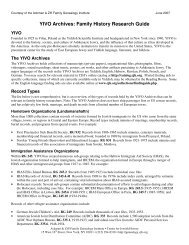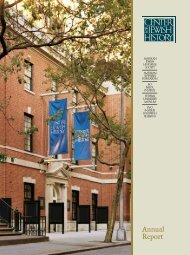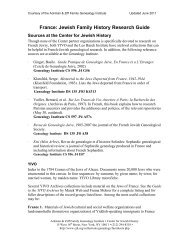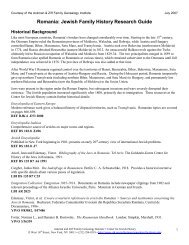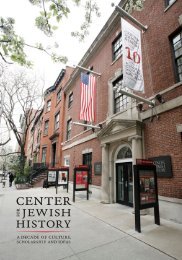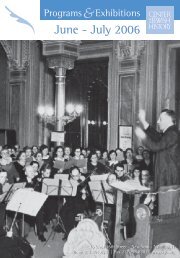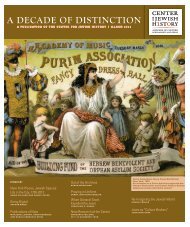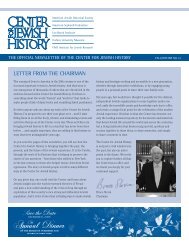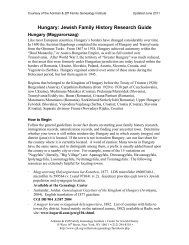ib singer ib singer ib singer ib singer ib singer - Center for Jewish ...
ib singer ib singer ib singer ib singer ib singer - Center for Jewish ...
ib singer ib singer ib singer ib singer ib singer - Center for Jewish ...
You also want an ePaper? Increase the reach of your titles
YUMPU automatically turns print PDFs into web optimized ePapers that Google loves.
Photo: Still from the film “The Rock and the Star”<br />
(Katia Mesel, 2004), showing a group of Brazilian<br />
<strong>Jewish</strong> women embroidering designs based on paintings<br />
by Franz Post, Echout, Rembrandt and others. Part<br />
of the exh<strong>ib</strong>it Pernambuco, Brazil; Gateway to New York.<br />
Brazil:<br />
The Hidden<br />
“<strong>Jewish</strong>” State<br />
by Monique Balbuena<br />
The coupling of the terms “Jew” and “Latino”<br />
often elicits surprise, especially in the US,<br />
where Jews are often identified as Ashkenazi,<br />
Yiddish-speaking, and Eastern European. However,<br />
<strong>Jewish</strong> communities in Latin America<br />
<strong>for</strong>med an essential part of their countries’ cultural<br />
fabric, and, as evidenced by the <strong>Center</strong> <strong>for</strong><br />
<strong>Jewish</strong> History’s current exh<strong>ib</strong>ition on Recife,<br />
Brazil and early settlement in New York (see<br />
sidebar), have had an enormous influence on<br />
American Jewry as well.<br />
As we rediscover the stories of <strong>Jewish</strong><br />
Latin American communities, we often mirror<br />
the process of contemporary <strong>Jewish</strong> Latino<br />
authors and writers themselves. In the words of<br />
Professor Edward H. Friedman, “a common<br />
motif of Latin American narrative is the rewriting<br />
of history, that is, the emendatory encoding<br />
of the <strong>Jewish</strong> subject into history.”<br />
Brazil, colonized by the Portugese, is a<br />
unique case in point. In the 16th century, the<br />
Portuguese were heavily identified as “gente da<br />
nação” (“people of the nation”), a euphemism<br />
<strong>for</strong> Jews. Erasmo, <strong>for</strong> example, wrote in 1530<br />
that the Portuguese were “a race of Jews.” In<br />
1674, Gaspar de Freitas Abreu complained that,<br />
“Only us, the Portuguese, among all the<br />
nations, are stigmatized as Jews or Marranos,<br />
and it’s a shame.” Portuguese diplomat Dom<br />
Luís da Cunha wrote in 1736 that “‘Portuguese’<br />
was synonymous with ‘Jew’ in <strong>for</strong>eign countries.”<br />
Indeed, although in 1496 Jews were<br />
<strong>for</strong>cefully baptized with holy water at the docks<br />
in Lisbon, the number of mixed marriages<br />
between Old Christians and New Christians —<br />
the baptized Jews — was so high by the 16th<br />
century that, scholar C.R. Boxer estimates,<br />
between one third and one half of the population<br />
in Portugal had some <strong>Jewish</strong> blood.<br />
The Portuguese were leaders of 16th century<br />
maritime expeditions, and in their pre-capitalist,<br />
expansionist and mercantilist endeavors.<br />
The colonial beginnings of Brazil are marked by<br />
the presence of New Christians and Crypto-Jews,<br />
who had a constant presence in the new territory<br />
as merchants, sugar plantation owners, slaveowners<br />
and traders, educators, writers and even<br />
priests. In his essay on the Sephardic experience<br />
in colonial Latin America, titled “These of the<br />
Hebrew Nation” (included in Martin A. Cohen<br />
and Abraham J. Peck’s anthology, Sephardim in<br />
the Americas), Allan Metz writes that “the <strong>Jewish</strong><br />
history of colonial Latin America … is essentially<br />
that of … New Christians who were<br />
judaizers. ... Well represented in commercial,<br />
professional, and political activities, the New<br />
Christian presence greatly enhanced Latin<br />
America’s development.” Brazilian Ambassador<br />
Rubens Ricupero assesses the interweaving of<br />
<strong>Jewish</strong> and Brazilian histories: “The origin of<br />
the country and the fate of the Sephardic Jews<br />
in the 15th and 16th centuries are inseparable<br />
threads of the same fabric.”<br />
This intimate association between<br />
Sephardic Jews and the beginnings of what<br />
would become the country of Brazil has had<br />
important effects on Brazilian customs, sayings<br />
and folk traditions. Not only were Crypto-Jews<br />
among the first writers of the colony, thereby<br />
leaving their mark in national literature, but<br />
the Brazilian <strong>Jewish</strong> environment also bore its<br />
imprint on <strong>Jewish</strong> literature. Recife, the capital<br />
of Pernambuco, where openly <strong>Jewish</strong> life flourished<br />
again under Dutch rule, has the oldest<br />
synagogue and mikveh of the Americas. The<br />
first Hebrew poem in the Americas was written<br />
there by Isaac Aboab da Fonseca, and there too<br />
were printed the first American <strong>Jewish</strong> books,<br />
in 1636. Recife also saw the initial Latin American<br />
contr<strong>ib</strong>ution to Responsa literature, and<br />
from there departed the twenty three Jews who<br />
continued on page 18<br />
Pernambuco,<br />
Brazil: The Gateway<br />
to New York<br />
350 years ago, twentythree<br />
Sephardic Jews<br />
from Recife, Brazil were<br />
<strong>for</strong>ced to flee their<br />
adopted homeland and<br />
found themselves on the<br />
shores of New York, then<br />
named New Amsterdam.<br />
Despite opposition<br />
from Governor Peter<br />
Stuyvesant, this small<br />
<strong>Jewish</strong> community was<br />
finally allowed entry into<br />
the city and took root in<br />
an American society far<br />
away from the reach of<br />
the Inquisition.<br />
Two partner institutions<br />
of the <strong>Center</strong> <strong>for</strong> <strong>Jewish</strong><br />
History, the Yeshiva<br />
University Museum and<br />
the American Sephardi<br />
Federation, are cosponsoring<br />
a special<br />
exh<strong>ib</strong>ition, Pernambuco,<br />
Brazil: Gateway to New<br />
York, on view through<br />
December 31, 2004. The<br />
exh<strong>ib</strong>ition depicts the<br />
historical and cultural life<br />
of Portuguese Jews from<br />
their first settlement in<br />
the early 1500s in Recife,<br />
Brazil until the historic<br />
exodus in 1654 of<br />
twenty-three members of<br />
the community who landed<br />
at New Amsterdam.<br />
Organized by Dr. Tania<br />
Kaufman, Director of the<br />
<strong>Jewish</strong> Historical Archive<br />
of Pernambuco in Recife,<br />
the exh<strong>ib</strong>ition illustrates<br />
the day-to-day lives of<br />
Sephardic Jews in Recife.<br />
For more in<strong>for</strong>mation,<br />
visit the <strong>Center</strong> <strong>for</strong><br />
<strong>Jewish</strong> History online<br />
at www.cjh.org.<br />
13



